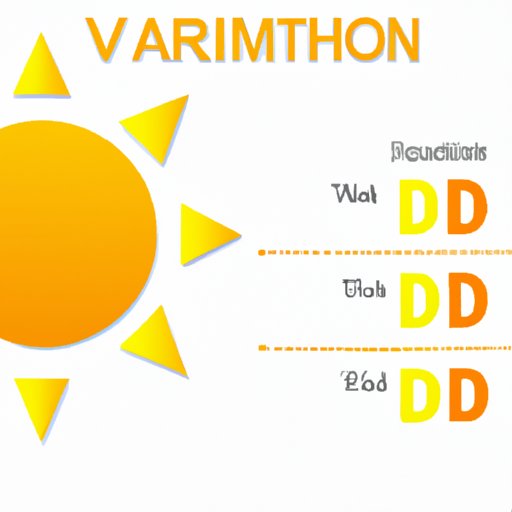
How Much Time in Sun for Vitamin D: The Optimal Sun Exposure
Vitamin D is a crucial nutrient that plays a vital role in maintaining healthy bones and teeth and supporting a robust immune system. A significant source of vitamin D comes from exposure to sunlight, which prompts the body to produce this essential nutrient. However, knowing how much time in the sun for Vitamin D production can be challenging, given the many factors that influence this process. In this article, we explore the optimal time in the sun for vitamin D production and offer guidelines for safe sun exposure to promote vitamin D synthesis while protecting the skin.
Exploring the Optimal Time in the Sun for Vitamin D Production
The sun’s ultraviolet B (UVB) rays trigger the synthesis of vitamin D3 in the skin, a process that plays a critical role in vitamin D production. However, the body’s ability to produce vitamin D depends on several factors, including the time of day, geographic location, and skin tone.
Experts suggest that midday sun exposure (between 10 am and 3 pm) is the most efficient time for vitamin D synthesis, as the sun’s rays are at their strongest, and the body can produce vitamin D in less time. The amount of exposure required to produce a sufficient amount of vitamin D varies depending on where you live and the season. For example, in locations closer to the equator, people require less sun exposure due to a higher concentration of UVB rays, while those living in latitudes far from the equator require more sun exposure to produce an adequate amount of vitamin D.
Skin tone is another crucial factor in vitamin D production, as people with darker skin absorb less UVB rays than people with lighter skin. As a result, those with darker skin tones need more sun exposure than those with lighter skin to produce the same amount of vitamin D.
How Much Sun is Too Much? A Guide for Healthy Sun Exposure and Vitamin D Synthesis
Although sun exposure is essential for vitamin D production, prolonged exposure to the sun may lead to skin damage, including skin cancer and sunburn. Therefore, establishing safe sun exposure guidelines is crucial in balancing vitamin D synthesis with skin protection. Experts suggest that the optimal amount of sun exposure to produce vitamin D should be balanced with the body’s need for protection from the sun’s harmful rays.
Experts advise people to avoid prolonged sun exposure, especially when the UV index is high. When outdoors, it is advisable to wear protective clothing to cover the skin, apply SPF 30 or higher sunscreen, and wear a hat and sunglasses to protect the face and eyes.
Getting Your Daily Dose of Vitamin D: How Long Should You Spend in the Sun?
The amount of sun exposure required to produce the recommended daily allowance of vitamin D varies depending on a person’s skin tone, how much skin is exposed, and the time of day they spend outside. However, according to experts, most people need 5-10 minutes of exposure to midday sun two to three times per week to maintain healthy vitamin D levels.
It is worth noting that the use of sunscreen can reduce the amount of vitamin D produced in the skin. Therefore, some experts suggest that people spend some time in the sun before applying sunscreen (at least 15 minutes) to enable the skin to start producing vitamin D before protection from the sun’s harmful rays.
Finding a Balance: Sun Exposure and Vitamin D Production
Finding a balance between sun exposure and skin protection is crucial for overall health and well-being. Experts recommend following safe sun exposure practices and taking supplements when necessary to maintain optimal vitamin D levels.
Other strategies for maximizing vitamin D synthesis through safe sun exposure include spending time outdoors during midday hours when the sun is at its peak, aiming for maximum skin exposure, and limiting exposure time to prevent sunburn and skin damage.
Vitamin D and the Sun: The Importance of Timing and Duration
Experts recommend spending between 5-30 minutes in the sun two to three times per week, depending on skin tone, location, and time of day. Additionally, people should focus on maintaining a well-balanced diet rich in nutrient-dense foods such as fatty fish, eggs, and dairy products, which are good sources of vitamin D.
Timing is also crucial, and the optimal time for vitamin D production is during midday when the sun’s rays are strongest. Experts recommend that people with lighter skin tones spend 10-15 minutes in the sun, while those with darker skin tones can benefit from 20-30 minutes of sun exposure.
The Science of Vitamin D: Understanding the Role of Sun Exposure in Health and Wellness
Current scientific research supports the importance of vitamin D in promoting overall health and well-being. In addition to supporting the body’s immune system and bone health, vitamin D may also play a role in reducing the risk of several chronic diseases, including multiple sclerosis, hypertension, and certain types of cancer.
The importance of sunlight exposure as a source of vitamin D has been well-established in current research. Still, experts advise that not all individuals can efficiently manufacture vitamin D from sunlight alone, which may lead to inadequate vitamin D levels.
Conclusion
In conclusion, getting enough vitamin D is important for overall health and well-being, and the sun is a crucial source of this essential nutrient. However, knowing how much time in the sun for vitamin D production is essential to balance vitamin D synthesis with skin protection. Experts recommend following safe sun exposure guidelines to maintain optimal vitamin D levels and protect the skin. By finding a balance between sun exposure and skin protection, individuals can optimize their vitamin D production and promote overall health and wellness.





